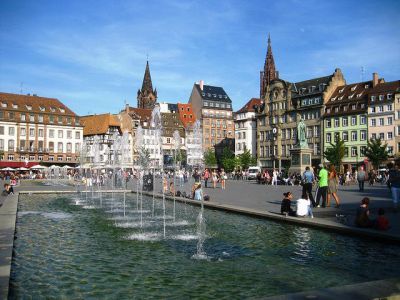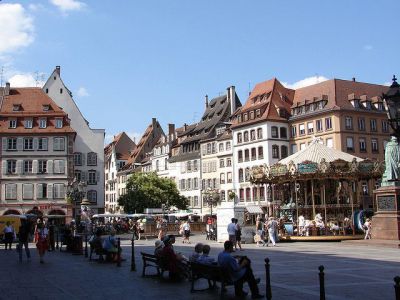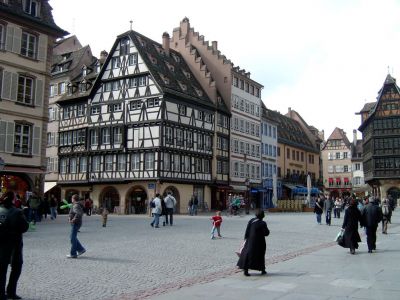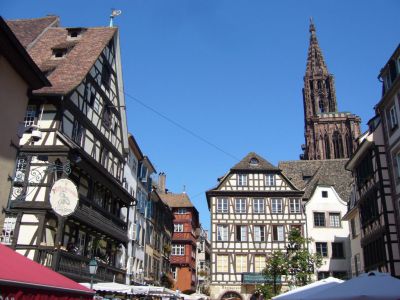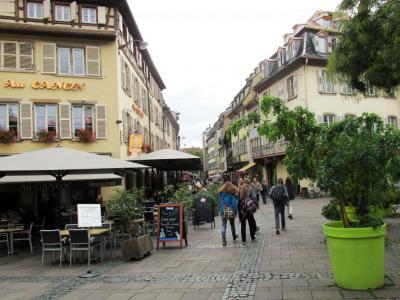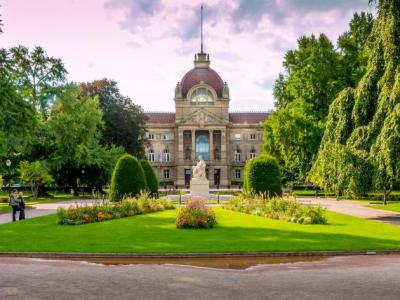Famous Squares Walking Tour (Self Guided), Strasbourg
Justly reputed as one of the most beautiful cities in all of France, Strasbourg greets visitors with an array of picturesque squares. Among the most famous of them are:
Place Kléber – the biggest square in the heart of the city’s commercial district; a central meeting place since the 14th century.
Place Gutenberg – a definite “must-see” in the heart of medieval Strasbourg, not far from the Cathedral.
Place de la Cathédrale (Cathedral Square) – one of the best places to admire the exterior of the magnificent Rayonnant Gothic Strasbourg Cathedral.
Place du Marché-aux-Cochons-de-Lait (Suckling Pigs Market Square) – surrounded by cute half-timbered architecture, this is indeed a charming place, well worth a visit.
Place du Corbeau (Raven Square) – a cute square, once infamously known as "near the bridge of execution" where criminals were dropped into the river Ill.
Place Saint Etienne (Saint Etienne Square) – a sweet little spot with nice food shops around and several half-timbered houses from the 18th century; a popular gathering place for Catholic students.
Place Broglie (Broglie Square) – a cluster of Strasbourg's major sights, in the center of Grand Île.
Place de la République (Republic Square) – one of the last remaining examples of fabulous pre-WWII German architecture.
If you care to spend time exploring some of the best known squares in Strasbourg, check out this self-guided walking tour.
Place Kléber – the biggest square in the heart of the city’s commercial district; a central meeting place since the 14th century.
Place Gutenberg – a definite “must-see” in the heart of medieval Strasbourg, not far from the Cathedral.
Place de la Cathédrale (Cathedral Square) – one of the best places to admire the exterior of the magnificent Rayonnant Gothic Strasbourg Cathedral.
Place du Marché-aux-Cochons-de-Lait (Suckling Pigs Market Square) – surrounded by cute half-timbered architecture, this is indeed a charming place, well worth a visit.
Place du Corbeau (Raven Square) – a cute square, once infamously known as "near the bridge of execution" where criminals were dropped into the river Ill.
Place Saint Etienne (Saint Etienne Square) – a sweet little spot with nice food shops around and several half-timbered houses from the 18th century; a popular gathering place for Catholic students.
Place Broglie (Broglie Square) – a cluster of Strasbourg's major sights, in the center of Grand Île.
Place de la République (Republic Square) – one of the last remaining examples of fabulous pre-WWII German architecture.
If you care to spend time exploring some of the best known squares in Strasbourg, check out this self-guided walking tour.
How it works: Download the app "GPSmyCity: Walks in 1K+ Cities" from Apple App Store or Google Play Store to your mobile phone or tablet. The app turns your mobile device into a personal tour guide and its built-in GPS navigation functions guide you from one tour stop to next. The app works offline, so no data plan is needed when traveling abroad.
Famous Squares Walking Tour Map
Guide Name: Famous Squares Walking Tour
Guide Location: France » Strasbourg (See other walking tours in Strasbourg)
Guide Type: Self-guided Walking Tour (Sightseeing)
# of Attractions: 8
Tour Duration: 2 Hour(s)
Travel Distance: 2.7 Km or 1.7 Miles
Author: irenebo
Sight(s) Featured in This Guide:
Guide Location: France » Strasbourg (See other walking tours in Strasbourg)
Guide Type: Self-guided Walking Tour (Sightseeing)
# of Attractions: 8
Tour Duration: 2 Hour(s)
Travel Distance: 2.7 Km or 1.7 Miles
Author: irenebo
Sight(s) Featured in This Guide:
- Place Kléber (Kleber Square)
- Place Gutenberg (Gutenberg Square)
- Place de la Cathédrale (Cathedral Square)
- Place du Marché-aux-Cochons-de-Lait (Suckling Pigs Market Square)
- Place du Corbeau (Raven Square)
- Place Saint Etienne (Saint Etienne Square)
- Place Broglie (Broglie Square)
- Place de la République (Republic Square)
1) Place Kléber (Kleber Square) (must see)
It is well worth taking time to visit the Place Kleber which is the biggest square in the heart of the city’s commercial district. The square has been a central meeting place since it was laid out in the 14th century and it took its name in 1840 after the General Jean Baptiste Kleber, whose statue stands in the center of the square. The general served in Napoleon’s army during the campaign in Egypt in 1798 and 1799. The statue was erected in 1838 by Philippe Grass.
When Napoleon returned to Paris, he named the Kleber Commander of the French Forces. Kleber was assassinated in 1800 in Cairo. His body was repatriated and kept in the Chateau d’If off the Marseille coast until being interred in his native Strasbourg thirty years later. The general’s remains are in a vault under the statue.
An interesting building along the north side of the square is the Aubette building, built in 1772 by Jacque-François Blondel. Once a military post, it was given its name in the 19th century, from the dawn (aube) changing of the guard. In 1928 three avant-garde artists Jean Arp, Theo van Doesburg and Sophie Taeuber-Arp decorated the interior of the building. This work of art is often called the "Sistine Chapel of Abstract Art" for its artistic beauty. Nowadays, the Aubette building is an artistic and historical landmark with on Place Kléber and is enjoyed by locals and tourists alike. Admission to the building is free.
When Napoleon returned to Paris, he named the Kleber Commander of the French Forces. Kleber was assassinated in 1800 in Cairo. His body was repatriated and kept in the Chateau d’If off the Marseille coast until being interred in his native Strasbourg thirty years later. The general’s remains are in a vault under the statue.
An interesting building along the north side of the square is the Aubette building, built in 1772 by Jacque-François Blondel. Once a military post, it was given its name in the 19th century, from the dawn (aube) changing of the guard. In 1928 three avant-garde artists Jean Arp, Theo van Doesburg and Sophie Taeuber-Arp decorated the interior of the building. This work of art is often called the "Sistine Chapel of Abstract Art" for its artistic beauty. Nowadays, the Aubette building is an artistic and historical landmark with on Place Kléber and is enjoyed by locals and tourists alike. Admission to the building is free.
2) Place Gutenberg (Gutenberg Square) (must see)
One destination that should be on your “must-see” list is the Place Gutenberg which lies in the center of medieval Strasbourg, not far from the Cathedral.
This large square is a favorite for locals and tourists alike as it has a lot of excellent cafes and restaurants. The Chamber of Commerce building occupies one side of the square and is easily recognizable with its Renaissance style, but with the sloping roof that is typical of Alsace, where winter snow is a way of life.
There is a 16th-century hotel on the square where Arthur Young was staying when revolutionists destroyed the city’s magistrates records and where today art exhibitions are held on the ground floor. Another attraction is the flea markets that often set up around the statue in the center of the square.
The statue is, quite obviously, dedicated to Johannes Gutenberg; it was sculpted by David d’Angers in 1840 and features the famous printer holding a piece of parchment on which is inscribed the words “Et la lumière fut” (And behold, there was light) from the Book of Genesis. Around the base of the statue, bas reliefs depict notable scenes from Gutenberg’s life.
Not many people know that apart from being the inventor of the first mechanical, movable printing press in Europe in 1439 and the publisher of the Gutenberg Bible in 1455, Gutenberg lived in Strasbourg between 1434-44, where he was an apprentice goldsmith, set to follow in his father’s footsteps.
This large square is a favorite for locals and tourists alike as it has a lot of excellent cafes and restaurants. The Chamber of Commerce building occupies one side of the square and is easily recognizable with its Renaissance style, but with the sloping roof that is typical of Alsace, where winter snow is a way of life.
There is a 16th-century hotel on the square where Arthur Young was staying when revolutionists destroyed the city’s magistrates records and where today art exhibitions are held on the ground floor. Another attraction is the flea markets that often set up around the statue in the center of the square.
The statue is, quite obviously, dedicated to Johannes Gutenberg; it was sculpted by David d’Angers in 1840 and features the famous printer holding a piece of parchment on which is inscribed the words “Et la lumière fut” (And behold, there was light) from the Book of Genesis. Around the base of the statue, bas reliefs depict notable scenes from Gutenberg’s life.
Not many people know that apart from being the inventor of the first mechanical, movable printing press in Europe in 1439 and the publisher of the Gutenberg Bible in 1455, Gutenberg lived in Strasbourg between 1434-44, where he was an apprentice goldsmith, set to follow in his father’s footsteps.
3) Place de la Cathédrale (Cathedral Square)
The Cathédral Square lies just north and west of the Strasbourg Cathedral. It is one of the best places to admire the exterior of the magnificent Rayonnant Gothic cathedral. The north side of the building, adjacent to the square, has some of the most impressive details and ornamentation.
The cathedral was begun in 1015, with significant contributions by architect Erwin von Steinbach starting in 1277. Work was continued by his son and then his grandson. The building was completed in 1439.
The impressive western face of the cathedral is best viewed from the square. Here you'll get a great view of the rose window. The three west portals each have particular themes to their decoration. The left shows the infancy of Christ, the central depicts the redemption, and the right shows the Last Judgement. The sculptures date to the 13th century.
As seen from the Cathedral Square, one of the most prominent features is the octagonal bell tower and spire. It is located on the northwest corner of the building. Despite plans for two towers, the building was completed with only one. The tower initially featured a Virgin Mary statue on the top, but this was replaced by a fleuron ornament in 1488.
At 142 meters (466 feet), the cathedral was the world's tallest building for 277 years, from 1647 until 1874. Today it is the sixth-tallest church in the world and the tallest building anywhere built in the Middle Ages.
The northern and western sides of the Cathedral Square, opposite the church, are home to various boutique shops and cafés. The square connects to the Frères Street on the east and Mercière Street on the west.
The cathedral was begun in 1015, with significant contributions by architect Erwin von Steinbach starting in 1277. Work was continued by his son and then his grandson. The building was completed in 1439.
The impressive western face of the cathedral is best viewed from the square. Here you'll get a great view of the rose window. The three west portals each have particular themes to their decoration. The left shows the infancy of Christ, the central depicts the redemption, and the right shows the Last Judgement. The sculptures date to the 13th century.
As seen from the Cathedral Square, one of the most prominent features is the octagonal bell tower and spire. It is located on the northwest corner of the building. Despite plans for two towers, the building was completed with only one. The tower initially featured a Virgin Mary statue on the top, but this was replaced by a fleuron ornament in 1488.
At 142 meters (466 feet), the cathedral was the world's tallest building for 277 years, from 1647 until 1874. Today it is the sixth-tallest church in the world and the tallest building anywhere built in the Middle Ages.
The northern and western sides of the Cathedral Square, opposite the church, are home to various boutique shops and cafés. The square connects to the Frères Street on the east and Mercière Street on the west.
4) Place du Marché-aux-Cochons-de-Lait (Suckling Pigs Market Square)
Place du Marché-aux-Cochons-de-Lait (French for “Suckling Pigs Market Square”) over the centuries has gone by many different names, featuring both German and French titles, reflecting the city's evolution and affiliation with the two countries.
Originally, back in 1240, it was known simply as Holzmerket (“Wood Market”), referring to the wood marketplace that used to occupy a vast space brought about by the emerging port activities in the Middle Ages. Then, in 1328, the area changed name to the more poetic Unter den Holzlüten (German: “Under the Wood Flowers”). In 1600 it became known as Holzstaden (German: “Wood Street”) and, in 1672, as Krautmarkt (German: “Herb Market”), followed by Pfährelmarkt (German: “Stake Market”, 1732), Alter Krautmarkt (German: “Old Herb Market”, 1735), Färelmarkt (1740), and Pfahlmarkt (1747).
In the 18th century, the French took over the renaming routine, progressively making it Marché aux Choux (“Cabbage Market”, 1771), Marché au Cochon de Lait (“Suckling Pig Market”, 1792), and Place de la Vertu (“Square of Virtue”, 1794). In the course of the 19th-20th centuries, as the city changed hands several times between France and Germany, the area subsequently came to be known as Marché-aux-Porcs (French: “Pig Market”, 1817), Place du Marché-aux-Cochons-de-Lait (French: “Suckling Pigs Market Square”, 1858, 1918), Neuer Fischmarkt (German: “New Fish Market”, 1872, 1940) and then Ferkelmarkt in 1944. The latter, though, proved to be short-lived, as the French swiftly made it back to Place du Marché-aux-Cochons-de-Lait in 1945.
Surrounded by cute half-timbered architecture, the square is indeed a charming place, well worth a visit. Located here also is a well, topped with a wrought iron structure, reportedly from the 18th century. Sources say, it replicates one of the four wells once found on the former Waffenplatz (now known as Place Kléber), which can be seen, in particular, on an engraving by Jean Hans, dated circa 1800.
Originally, back in 1240, it was known simply as Holzmerket (“Wood Market”), referring to the wood marketplace that used to occupy a vast space brought about by the emerging port activities in the Middle Ages. Then, in 1328, the area changed name to the more poetic Unter den Holzlüten (German: “Under the Wood Flowers”). In 1600 it became known as Holzstaden (German: “Wood Street”) and, in 1672, as Krautmarkt (German: “Herb Market”), followed by Pfährelmarkt (German: “Stake Market”, 1732), Alter Krautmarkt (German: “Old Herb Market”, 1735), Färelmarkt (1740), and Pfahlmarkt (1747).
In the 18th century, the French took over the renaming routine, progressively making it Marché aux Choux (“Cabbage Market”, 1771), Marché au Cochon de Lait (“Suckling Pig Market”, 1792), and Place de la Vertu (“Square of Virtue”, 1794). In the course of the 19th-20th centuries, as the city changed hands several times between France and Germany, the area subsequently came to be known as Marché-aux-Porcs (French: “Pig Market”, 1817), Place du Marché-aux-Cochons-de-Lait (French: “Suckling Pigs Market Square”, 1858, 1918), Neuer Fischmarkt (German: “New Fish Market”, 1872, 1940) and then Ferkelmarkt in 1944. The latter, though, proved to be short-lived, as the French swiftly made it back to Place du Marché-aux-Cochons-de-Lait in 1945.
Surrounded by cute half-timbered architecture, the square is indeed a charming place, well worth a visit. Located here also is a well, topped with a wrought iron structure, reportedly from the 18th century. Sources say, it replicates one of the four wells once found on the former Waffenplatz (now known as Place Kléber), which can be seen, in particular, on an engraving by Jean Hans, dated circa 1800.
5) Place du Corbeau (Raven Square)
Located near the Corbeau bridge spanning the Ill River in Strasbourg, the Raven Square (Place du Corbeau) has a historically intriguing background. From the 14th to the 17th centuries, this square bore the infamous moniker Bei der Schindbrücke in German, meaning "near the bridge of execution." The origin of this grim name stems from the fact that the bridge in question was the site where condemned criminals, confined within a cage, were plunged into the river to meet their end.
In 1849, the square adopted its current name, but in 1872, due to the German annexation of Alsace-Lorraine, it underwent a swift renaming as Rabenplatz (or Raweplatz in Alsatian). The original name of Place du Corbeau was reinstated in 1918 following these changes. However, the tumultuous periods of history continued to impact the square's nomenclature. During the Nazi occupation of France from 1940 to 1944, it reverted to being called Rabenplatz once again. Thankfully, upon liberation, the French title was rightfully reinstated.
Regrettably, the ravages of World War II resulted in the loss of four splendid houses that had proudly adorned the Ill River banks and overlooked the square from the 16th to the 18th centuries. Among the fortunate survivors is the Brasserie du Canon, an ancient brewery where Jérôme Hatt first crafted Kronenbourg beer in 1664.
In 1849, the square adopted its current name, but in 1872, due to the German annexation of Alsace-Lorraine, it underwent a swift renaming as Rabenplatz (or Raweplatz in Alsatian). The original name of Place du Corbeau was reinstated in 1918 following these changes. However, the tumultuous periods of history continued to impact the square's nomenclature. During the Nazi occupation of France from 1940 to 1944, it reverted to being called Rabenplatz once again. Thankfully, upon liberation, the French title was rightfully reinstated.
Regrettably, the ravages of World War II resulted in the loss of four splendid houses that had proudly adorned the Ill River banks and overlooked the square from the 16th to the 18th centuries. Among the fortunate survivors is the Brasserie du Canon, an ancient brewery where Jérôme Hatt first crafted Kronenbourg beer in 1664.
6) Place Saint Etienne (Saint Etienne Square)
Nestled within a tranquil nook of Strasbourg's Grand Island (Grand Île), lies Place Saint Etienne, a petite and charming medieval square adorned with a collection of 18th-century half-timbered houses. Originally constructed in the 11th century under the name "Saint Pierre-Large," the square adopted its present moniker in 1400.
At the heart of the square, shielded by a pair of lime trees, rests the Meiselocker fountain, erected in 1929. This creation by Ernst Weber was a gift from Munich to Strasbourg, an exchange for the Vater Rhein fountain bestowed upon Munich.
Among the other noteworthy attractions here is the Foyer de l'Étudiant Catholique, established at the birthplace of Paul Appell, along with the Saint-Étienne church situated within the Saint-Étienne Episcopal College.
Once a location where the local Assembly of Nobles convened, this square has transformed into a favored gathering hub for Catholic students, particularly following its revitalization in 2014.
At the heart of the square, shielded by a pair of lime trees, rests the Meiselocker fountain, erected in 1929. This creation by Ernst Weber was a gift from Munich to Strasbourg, an exchange for the Vater Rhein fountain bestowed upon Munich.
Among the other noteworthy attractions here is the Foyer de l'Étudiant Catholique, established at the birthplace of Paul Appell, along with the Saint-Étienne church situated within the Saint-Étienne Episcopal College.
Once a location where the local Assembly of Nobles convened, this square has transformed into a favored gathering hub for Catholic students, particularly following its revitalization in 2014.
7) Place Broglie (Broglie Square)
Many of the biggest sights in Strasbourg are centered around Broglie Square. This square is large and rectangular, and it lies in the center of the Grand Île city center. You'll find the opera house, the city hall, the Governor's Palace, Prefect's Palace along its edges. There's also the Strasbourg branch of the Bank of France and the Mess building.
With its central location and many points to see, it's no wonder that Place Broglie is a meeting place and point of convergence in the city. The city's tram lines stop here. It is also here that the city's annual Christmas market is held.
You'll see a wide variety of architectural styles around the square, each of which tells a little bit of Strasbourg's story. Among the styles you can count Renaissance, Rococo, Nouveau, Historicism, and Alsatian.
There are also several monuments you will notice around the square. Near the base of the Bridge Theatre, you will find the Janus fountain. Built in 1988, it was dedicated to the 2000th anniversary of the first recorded mentions of Argentoratum which was Strasbourg's name in Roman times. Argentoratum was first recorded as a military outpost in 12 BC.
Next to the Opera House, there is a sandstone obelisk with bronze statues dedicated to Philippe Leclerc de Hauteclocque and the Liberation of Strasbourg during World War II. This monument was dedicated in 1951.
With its central location and many points to see, it's no wonder that Place Broglie is a meeting place and point of convergence in the city. The city's tram lines stop here. It is also here that the city's annual Christmas market is held.
You'll see a wide variety of architectural styles around the square, each of which tells a little bit of Strasbourg's story. Among the styles you can count Renaissance, Rococo, Nouveau, Historicism, and Alsatian.
There are also several monuments you will notice around the square. Near the base of the Bridge Theatre, you will find the Janus fountain. Built in 1988, it was dedicated to the 2000th anniversary of the first recorded mentions of Argentoratum which was Strasbourg's name in Roman times. Argentoratum was first recorded as a military outpost in 12 BC.
Next to the Opera House, there is a sandstone obelisk with bronze statues dedicated to Philippe Leclerc de Hauteclocque and the Liberation of Strasbourg during World War II. This monument was dedicated in 1951.
8) Place de la République (Republic Square)
Republic Square (Place de la République) stands as one of the principal plazas within Strasbourg's "German quarter." This square is encompassed on three sides by a collection of five edifices, each void of residential occupancy. These notable structures include the Palais du Rhin, the National and University Library, the Théâtre national de Strasbourg, the Préfecture of Grand Est and Bas-Rhin, and the Hôtel des Impôts, which serves as the tax center. Notably, all of these architectural marvels are classified as Historical Monuments.
The mastermind behind the design of Republic Square was the architect Jean-Geoffroy Conrath (1824–1892), who envisioned this space during the period of Reichsland. It was intended to serve as a grand and impressive gateway to the Neustadt, situated across the Ill River from the historic heart of the city, Grande Île. The square's design and construction began in 1880, initially named "Imperial Square." Notably, a group of Ginkgo biloba trees, also known as Maidenhair trees, were brought from Japan by Emperor Meiji and were planted in the central garden during the 1880s. These trees, a testament to history, still grace the square with their presence today.
At the heart of Republic Square, an impactful War memorial sculpture created by Léon-Ernest Drivier commands attention. Unveiled in 1936, this statue portrays a mother cradling two fallen sons, symbolizing the intricate historical narrative of Strasbourg, oscillating between the influences of Germany and France. This poignant memorial took the place of an equestrian statue of Emperor Wilhelm I, which had been commissioned in 1897 and previously held its stance on the square from 1911 until 1918.
Why You Should Visit:
To see one, if not the only, remaining example of fabulous German architecture in the world since all the stunning examples in Germany were destroyed in WWII.
The mastermind behind the design of Republic Square was the architect Jean-Geoffroy Conrath (1824–1892), who envisioned this space during the period of Reichsland. It was intended to serve as a grand and impressive gateway to the Neustadt, situated across the Ill River from the historic heart of the city, Grande Île. The square's design and construction began in 1880, initially named "Imperial Square." Notably, a group of Ginkgo biloba trees, also known as Maidenhair trees, were brought from Japan by Emperor Meiji and were planted in the central garden during the 1880s. These trees, a testament to history, still grace the square with their presence today.
At the heart of Republic Square, an impactful War memorial sculpture created by Léon-Ernest Drivier commands attention. Unveiled in 1936, this statue portrays a mother cradling two fallen sons, symbolizing the intricate historical narrative of Strasbourg, oscillating between the influences of Germany and France. This poignant memorial took the place of an equestrian statue of Emperor Wilhelm I, which had been commissioned in 1897 and previously held its stance on the square from 1911 until 1918.
Why You Should Visit:
To see one, if not the only, remaining example of fabulous German architecture in the world since all the stunning examples in Germany were destroyed in WWII.
Walking Tours in Strasbourg, France
Create Your Own Walk in Strasbourg
Creating your own self-guided walk in Strasbourg is easy and fun. Choose the city attractions that you want to see and a walk route map will be created just for you. You can even set your hotel as the start point of the walk.
Strasbourg Introduction Walking Tour
The capital of France's Grand Est region, formerly known as Alsace, Strasbourg is often referred to as the "crossroads of Europe". Indeed, the city's name, emerged after the 5th century AD, is the German for 'town (at the crossing) of roads'. Adding truth to it today also is the European Parliament that has been seated at Strasbourg since 1949.
The vicinity of the... view more
Tour Duration: 2 Hour(s)
Travel Distance: 2.8 Km or 1.7 Miles
The vicinity of the... view more
Tour Duration: 2 Hour(s)
Travel Distance: 2.8 Km or 1.7 Miles
Strasbourg Downtown Walking Tour
Strasbourg – the daughter of the Rhine River – is rich in history, architecture and gastronomy. This is particularly true of the downtown part of the city, the Grande Île or Große Insel in German, which means "Large Island" – a designated UNESCO World Heritage Site since 1988.
At the centre of the island lies Place Kléber, the city's central square and main meeting... view more
Tour Duration: 1 Hour(s)
Travel Distance: 1.5 Km or 0.9 Miles
At the centre of the island lies Place Kléber, the city's central square and main meeting... view more
Tour Duration: 1 Hour(s)
Travel Distance: 1.5 Km or 0.9 Miles
Historical Churches Walking Tour
Strasbourg, which celebrated its bimillennial anniversary in 1988, is a city with a very rich heritage. Among other historical monuments found here is a wealth of ancient churches and cathedrals, representing a variety of architectural styles. Exploring Strasbourg on foot, one is inevitably drawn to visit some of these locations. Here are some of the best known places of worship in the city.
... view more
Tour Duration: 2 Hour(s)
Travel Distance: 3.0 Km or 1.9 Miles
... view more
Tour Duration: 2 Hour(s)
Travel Distance: 3.0 Km or 1.9 Miles
The Most Popular Cities
/ view all



